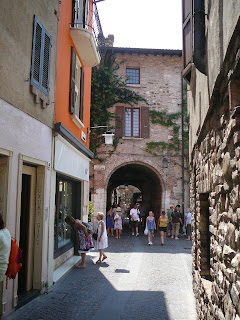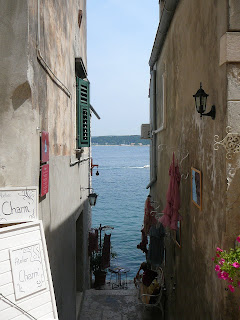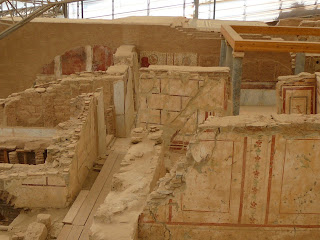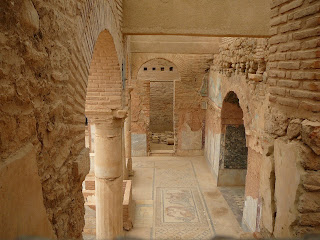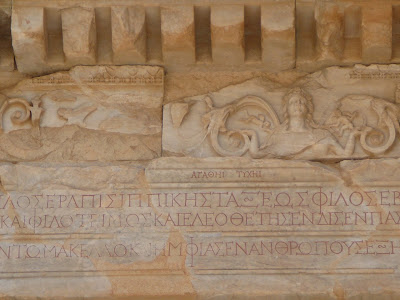From Italy, we fly to England to board the Queen Mary 2 which sails from Southampton to New York. I had great hopes that this would prove to be one of the highlights of the entire trip, but sadly it is not.It is notable only for its mediocrity. Nothing about it has created any inspiration for my writing. It is neither bad enough for a rant nor good enough for a rave. I would in fact ignore it, but so many people have asked for my comments on sailing on the Queen Mary that I have to write something.
It is huge (2600 passengers) which many people like, but I prefer smaller ships where you get to know the staff and your fellow passengers. There are, as far as I can see, no interesting characters and no photo ops.
The most noticeable thing about sailing on the Queen Mary is that it is immediately apparent that this ship, like no other we have been on, seems to have a very obvious class system in effect, which Cunard clearly encourages. The ship divides its passengers into two groups – those who are prepared to pay a premium for a stateroom on a higher deck, with an open balcony and access to an exclusive restaurant, and those who are not, who dine in a room open to all. Now I know you are all assuming that I am in the first group, but I have to tell you, dear readers, that much to my chagrin, I am not. Dear Gordon, or Ed as he is now affectionately known, has decided that a little economy is in order, and as much as I hate that word, I have agreed. Consequently I find myself in the second group. And this group also seems to be divided between those who have an outside stateroom (some with “sheltered” balconies), and those who have inside staterooms (of which there is a great number) which are windowless and amazingly affordable.
The other noticeable division is created by the enforced dress code. If you want to eat in one of the formal dining rooms you must abide by the dress code, which is formal for three nights (black tie/evening dress), and semi formal for the other nights (jacket and tie for men, cocktail dress for women). A large contingent of passengers (including us) adopt this way of life with gusto and enjoy parading through the ship in our finery. Others are much happier in their shorts and T shirts and windowless cabins, and appear quite content to eat in what looks like a giant food court lifted out of an American Mall. The food however is not inspiring in either the formal restaurants or the food hall and lags far behind Oceania in that regard, and doesn't even measure up to Celebrity.
The cabins however (or staterooms as the industry likes to call them) are the largest cabins we have experienced, and very comfortable if rather bland in their décor. The balconies are also larger than any we have seen. But in a throwback to years gone by that we cannot understand, this is the only ship that allows smoking in the cabins. Consequently the cabins smell of smoke and the corridors reek of it. It is at times almost unbearable for us non-smokers.
Whilst I readily admit to a preference for smaller ships, they cannot compete with the amazing scale and glamour of a ship of this size. There is definitely more than a touch of fabulosity in the huge sweeping staircases and luxuriously wide passageways filled with art deco sculptures, huge bas relief panels, crystal chandeliers and enormous paintings . But while the corridors, staircases and elevators have embraced scale with great elan, there is little pizzaz in the cafes, bars and restaurants which seem notable only for their seating capacity. The dining rooms fail to impress and do not appear as grand as the ones on Celebrity. Women and gay men love to slowly descend the obligatory sweeping staircase from the upper level of the restaurant to the main floor, hoping that all eyes are on them admiring their fabulous outfit specially selected for the evening. But here the staircase is distinctly cramped compared to Celebrity and does not allow for the same grand (or camp) entry.
Ships of this scale also have more money available for entertainment, and here the QM2 is unmatched by any ship I have been on. The entertainment definitely sets the fabulosity meter going. There are two theatres, a ballroom, two bands, a string quartet and a harpist onboard. The evening shows and daily lectures are wonderful as are the rather outrageous tea dances. We have the pleasure of listening to two lectures by P.D. James and two by the English actress Celia Imrie, as well as several others by perhaps less well known but equally interesting presenters. The evening shows in the the theatre are all excellent. They are usually followed by a formal dance in the ballroom - the largest found on any ship. These are amazingly well attended by the formally attired class of passenger most of whom seem to delight in the old fashioned world of a big band playing playing dance music from the 30's and 40's. This is also the last ship sailing to have “gentlemen hosts', who attend all the dances and have the unenviable duty of inviting all the single women to dance. They are not, we understand, allowed to sit out one dance and must never dance with the same lady two dances in a row. We hear stories of how many of them are pursued with great enthusiasm and astounding energy by some of the widows and spinsters who would like to be taken for a spin around a completely different floor. One look at the widows and spinsters would persuade you that this is not an added benefit to the job of being a “gentlemen host”. And indeed the “gentlemen hosts” are mostly over 60, if not over 70. It is hard to believe that having been on the dance floor all afternoon and evening, any of them would have the energy or enthusiasm for extra curricular activities.
While all of this is going on, I am not sure what the short and T shirt brigade do, but it is interesting to note that few of them seem interested in gatecrashing the ballroom.
And so on the 6th day of an enjoyable but uninspiring cruise, we arrive in New York and our two month trip comes to an end.
We disembark to a large hall where we have to try and find our luggage. There is a very well put together gentleman, slowly unraveling because he is unable to find his suitcase. He confronts someone who appears to be in charge. She is a tall and rather imposing African American woman, who has clearly dealt with people of his ilk many times before. He is fast losing his temper, and a flush of red is rising through his cheeks. His bellowing voice, tinged with rage, echoes across the room as he demands that something be done about his missing luggage.
The woman merely observes this tirade with a cold and unaffected stare. Finally her right hand rises to shoulder level and falls with a rapid zig zag motion, her long painted fingernails cutting through the air. She refrains from snapping her fingers but says with a long and pronounced drawl on the first word
“Honneeeee, there are only two people in the entire world who care about your suitcase. You are one, and you are screaming at the other. Do you really think that is wise?”
She's sort of fabulous!



